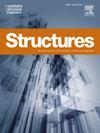Research on the shear performance of groove-reserved prefabricated steel-concrete composite slab-beam connection
IF 3.9
2区 工程技术
Q1 ENGINEERING, CIVIL
引用次数: 0
Abstract
The groove-reserved slab-beam connection offers advantages such as high degree of prefabrication, good overall mechanical performance, and ease of construction, making it one of the most optimal solutions for building prefabricated composite beams. The construction process of this structure is as follows: steel beams with shear connectors and concrete slabs with reserved grooves on the underside are prefabricated in the factory, and after being transported to the construction site, the slab-beam connection is completed by pouring concrete into the grooves of the precast slabs. Existing studies on the shear performance and optimal design of groove-reserved slab-beam connections remain insufficient, limiting their practical application. To address this, five full-scale push-out tests were conducted, and finite element models of structures with new-to-old concrete interfaces were developed. The calculation results from design formulas in relevant codes were compared. The results indicate that when designing the shear capacity of this connection structure, both the shear capacity of the new-to-old concrete interface and the shear connectors should be simultaneously verified. Using Ultra-High-Performance Concrete instead of Shrinkage-Compensating Concrete as post-cast concrete increases the shear capacity of the new-to-old concrete interface by 9 %, while incorporating key-tooth structures at the grooves enhances the shear capacity by 13 %. Additionally, the effects of shear rebar quantity, interface roughness, and pre-compression force on the shear capacity of the new-to-old concrete interface were investigated.
预留槽预制钢-混凝土组合板-梁连接抗剪性能研究
预留槽板梁连接具有预制程度高、整体力学性能好、施工方便等优点,是建造预制组合梁的最佳解决方案之一。本结构的施工流程为:在工厂预制带剪力连接件的钢梁和底面预留槽的混凝土板,运输到施工现场后,将混凝土灌入预制板槽内,完成板梁连接。目前对预留槽板梁连接的抗剪性能及优化设计研究不足,限制了其实际应用。为了解决这个问题,进行了五次全尺寸推出试验,并开发了具有新旧混凝土界面的结构的有限元模型。比较了相关规范中设计公式的计算结果。结果表明,在设计该连接结构抗剪承载力时,应同时对新旧混凝土界面和抗剪连接件的抗剪承载力进行校核。采用超高性能混凝土代替收缩补偿混凝土作为后浇筑混凝土,可使新旧混凝土界面的抗剪能力提高9 %,而在槽处采用键齿结构可使抗剪能力提高13 %。此外,还研究了抗剪钢筋数量、界面粗糙度和预压力对新老混凝土界面抗剪能力的影响。
本文章由计算机程序翻译,如有差异,请以英文原文为准。
求助全文
约1分钟内获得全文
求助全文
来源期刊

Structures
Engineering-Architecture
CiteScore
5.70
自引率
17.10%
发文量
1187
期刊介绍:
Structures aims to publish internationally-leading research across the full breadth of structural engineering. Papers for Structures are particularly welcome in which high-quality research will benefit from wide readership of academics and practitioners such that not only high citation rates but also tangible industrial-related pathways to impact are achieved.
 求助内容:
求助内容: 应助结果提醒方式:
应助结果提醒方式:


